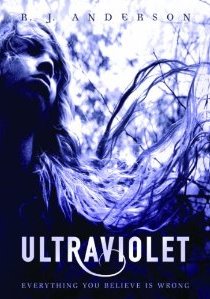| ________________
CM . . .
. Volume XVIII Number 29. . . .March 30, 2012 
 |
Ultraviolet.
R. J. Anderson.
Minneapolis, MN, Carolrhoda Lab/Lerner Publishing Group, 2011.
306 pp., hardcover, $17.95 (US).
ISBN 978-0-7613-7408-4.
Subject Headings:
Synesthesia-Fiction.
Emotional problems-Fiction.
Extraterrestrial beings-Fiction.
Science fiction.
Grades 7-12 / Ages 12-17.
Review by Rob Bittner.
***½ /4
|
| |
|

excerpt:
Once upon a time there was a girl who was special. Her hair flowed like honey and her eyes were blue as music. She grew up bright and beautiful, with deft fingers, a quick mind, and a charm that impressed everyone she met. Her parents adored her, her teachers praised her, and her schoolmates admired her many talents. Even the oddly shaped birthmark on her arm seemed like a sign of some great destiny.
This is not her story.
Unless you count the part where I killed her.
Sixteen-year-old Alison wakes up in a Psychiatric Unit and can't remember how she came to be there. As she begins to piece together the fragments of her fractured memories, a terrible realization emblazons itself upon her mind: her school enemy, Tori, disintegrated—vanished into nothing—and it's all her fault. While Alison is recovering from her traumatic experience and trying to understand exactly what happened the day Tori disappeared, the enigmatic and violet-eyed Dr. Faraday comes to Pine Hills treatment centre and changes Alison's life forever. Through Faraday, Alison is able to understand herself and how she sees the world, a way of seeing things that has frightened her mother and caused her to believe she is insane. Alison is a synesthete, a condition that causes her to see numbers as colours, smell words, and taste lies. Faraday believes Alison's condition is the key to solving a mystery beyond anything she could imagine.
R. J. Anderson's style is smooth and catchy, evoking brilliant imagery and immersing readers in the world as seen through a lens of synesthesia. The plot is very fluid, utilizing flashbacks that bring the present into focus little by little. Anderson draws in her audience with extraordinary clues in ordinary conversations, leaving readers guessing until the end, whether or not there is a supernatural or other-worldly quality to the narrative. Everyday talk of aliens and conspiracy theories that would otherwise seem inane are made suspect through Anderson's clever dialogue and descriptions.
Alison is a strong female protagonist, though one who is unfortunately at the mercy of many overarching authority figures and power structures. She is a complex character with whom readers will be able to identify, or at least admire. Her synasthesia is constantly undermining her attempts to appear sane for the sake of the doctors and nurses in Pine Hills. As Alison begins to understand the events that took place on the day Tori disappeared, she begins to fear for her own sanity and well-being. With the help of Faraday, Alison finally begins to understand what happened to Tori, and the two of them embark on a journey to clear Alison's name and find out once and for all whether or not she is innocent.
The supporting cast of characters is a mix of solid and flat. Faraday, though more of a main character in many ways, is still secondary to Alison, who is also the narrator. Anderson's descriptions of Faraday and his violet eyes, as well as the way he looks and smells to Alison, keep the reader guessing as to his real identity and purpose for being at Pine Hills. Dr. Minta, Alison's psychologist, is neither the perfect counsellor, nor the stereotypical terrible doctor; he is a human being doing what he feels is best to help Alison recover from her trauma. Tori is also quite strongly written, and her character is jam-packed with nuance and subtlety that Anderson lets readers see bit by bit as the story unfolds. Kirk and Micheline, two other patients at Pine Hills, feel somewhat flat in comparison to the others, more stock characters to move points of the plot forward than actual people. Sanjay, another patient, is a typical conspiracy theorist, talking about aliens and space travel. But the parts of his theories that are correct never seem to get explained in the end—his ability to know the truth is never unraveled—which may be frustrating to some. Alison's mother is also a bit uneven, feeling at times fully-realized and whole, but then at other times simply a melodramatic woman on the sidelines. While some of these characters feel somewhat unsubstantial, they do not take away from the central plot and narrative.
Overall the novel is intriguing, enigmatic, and reads like a young adult version of an Agatha Christie mystery with conspiracy theories and alien subplots brought in for good measure. The last part of the novel, it should be noted, feels somewhat rushed and a little more scattered than the first two parts. The pacing is steady and the writing more controlled leading up to the climax, but after Faraday's true identity is revealed and Tori's place in the grand scheme of things comes out, Anderson's style changes and feels rushed, and perhaps a bit more choppy. This, however, does not change the fact that Ultraviolet as a whole is intricate, mystifying, and cohesive; it is a novel that is both addictive and mesmerizing.
Highly Recommended.
Rob Bittner is a graduate of the MA in Children's Literature program at The University of British Columbia in Vancouver, BC. He will begin doctoral studies at Simon Fraser University in September 2012.

To comment
on this title or this review, send mail to cm@umanitoba.ca.
Copyright © the Manitoba Library Association. Reproduction for personal
use is permitted only if this copyright notice is maintained. Any
other reproduction is prohibited without permission.
NEXT REVIEW |
TABLE OF CONTENTS FOR THIS ISSUE
- March 30, 2012.
AUTHORS |
TITLES |
MEDIA REVIEWS |
PROFILES |
BACK ISSUES |
SEARCH |
CMARCHIVE |
HOME |
